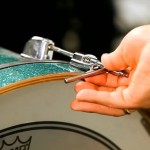Adjusting The Sounds Of Your Cajon Drum
Posted in Learn | Last Updated on October 19, 2019
 One of the benefits of playing the Cajon Drum is it can be adjusted to make different sounds. From first glance you might think that this drum is just a box. In actuality there are several adjustments we can do to change the sound. Today we are going to talk about how to adjust the snare area around the edge or corner where the slap or crack sound is made to enhance your instrument drumming experience.
One of the benefits of playing the Cajon Drum is it can be adjusted to make different sounds. From first glance you might think that this drum is just a box. In actuality there are several adjustments we can do to change the sound. Today we are going to talk about how to adjust the snare area around the edge or corner where the slap or crack sound is made to enhance your instrument drumming experience.
To adjust the corner or crack tone you must first go to the far corner of the faceplate. The crack can be adjusted from a slow or loose sound to a loud pronounced crack. To change this to your liking you first need a Phillips Head screwdriver. Find the screw that joins the edges together and turn the screw to the right to tighten the gap and reduce the crackle effect.
If you do not care for the crackle sound, you may totally emit the noise all together by tightening the screw all the way to the right. Make sure not to tighten it too much, you do not want to make it too hard to loosen when you want to adjust the crackle sound again. For more crackle, turn your screw driver to the left, keep adjusting until you reach the sound you are looking for. Don’t forget to do the same on the opposite corner to achieve a balanced sound effect while playing with both hands.
There are some cajon drums that come with fully adjustable snares on the inside that is in contact with the faceplate. To make the adjustments needed to control the snare effect, you may either tighten or loosen the knob and adjust the snare levels. You can choose to totally turn off the snare by tightening it all the way. The only way to find out how this snare works is to take the faceplate totally off the Cajon. By taking off the faceplate you can explore the inside of box and how it makes the different sounds.
Make sure you look closely at the knob on the outside. The knob on the outside connects with the snare wires on the inside. Rolling the knob forward you will notice how the snares come in contact with the inside of the faceplate. Roll the knob back, and notice how the contact is reduced. Turning this knob precisely you can choose just how much snare effect you are looking for while playing your cajon drum.
Other thing you can do is to tune the strings tighter for a tighter, cleaner sound and a fast response, and loosen them for more snare sound, higher frequencies and sustain.
An additional tiny ''cheat'' a person can do is to tape particular parts of the strings towards the inside of the front panel of the instrument.
This is very helpful particularly if your strings have began to get a bit loose and you get a buzzing sound. Where you place the tape would certainly depend on where the problem lies, thus you will once again, use your own intuition and give it another try, check it out, get to know your cajon and get to know what sounds you like and which sounds you want to avoid.
You could also put a towel inside of it to decrease snare sounds and buzzing. There are many other tweaks, we shall dedicate a whole another article about them.









